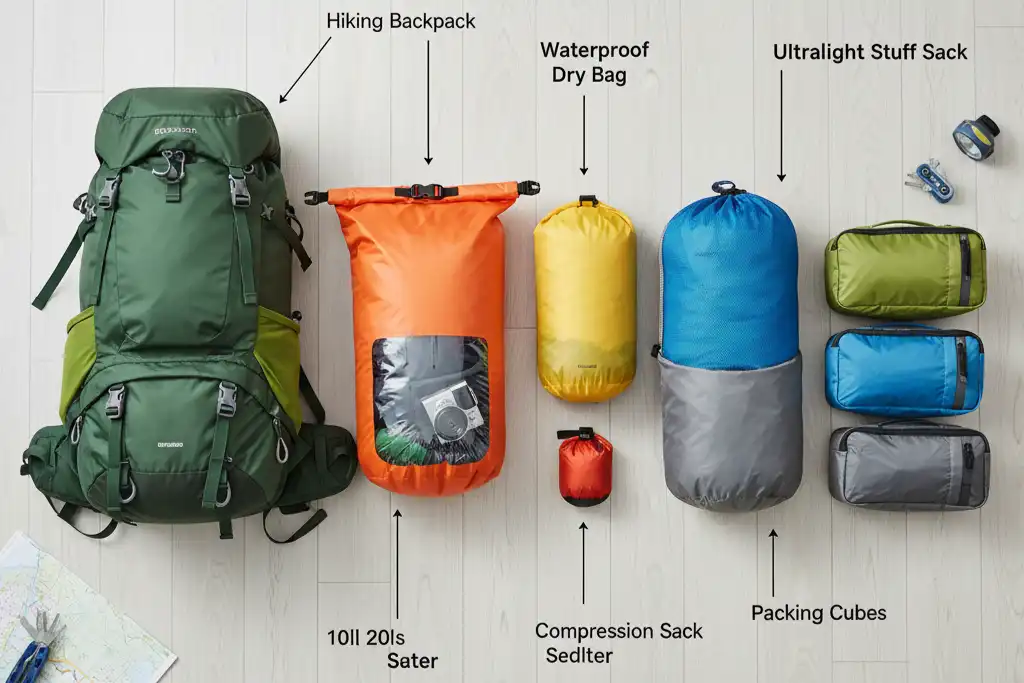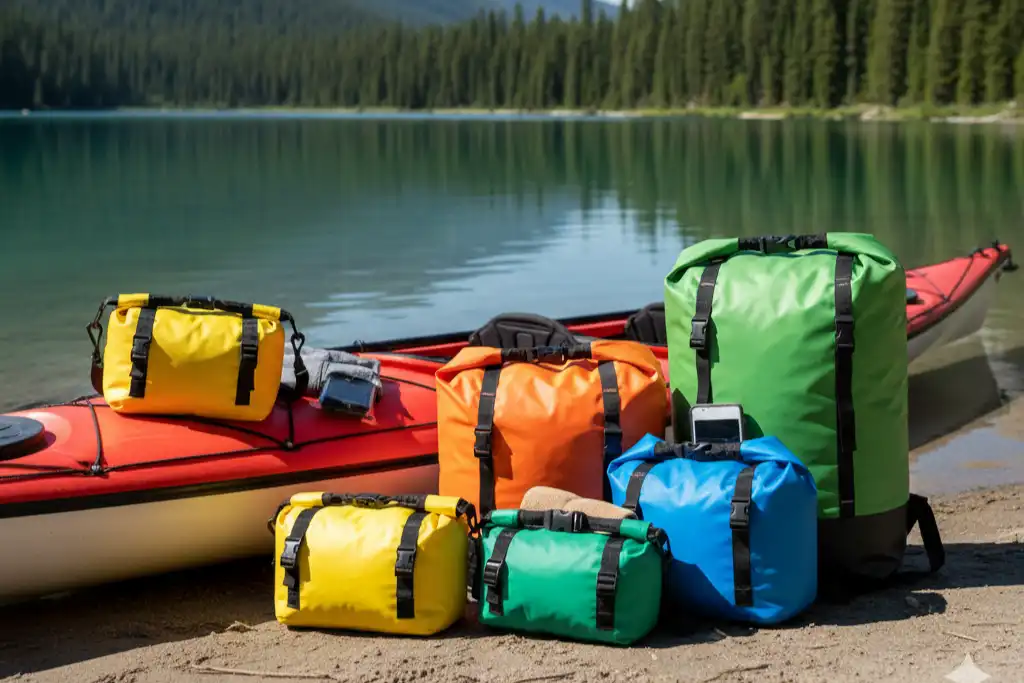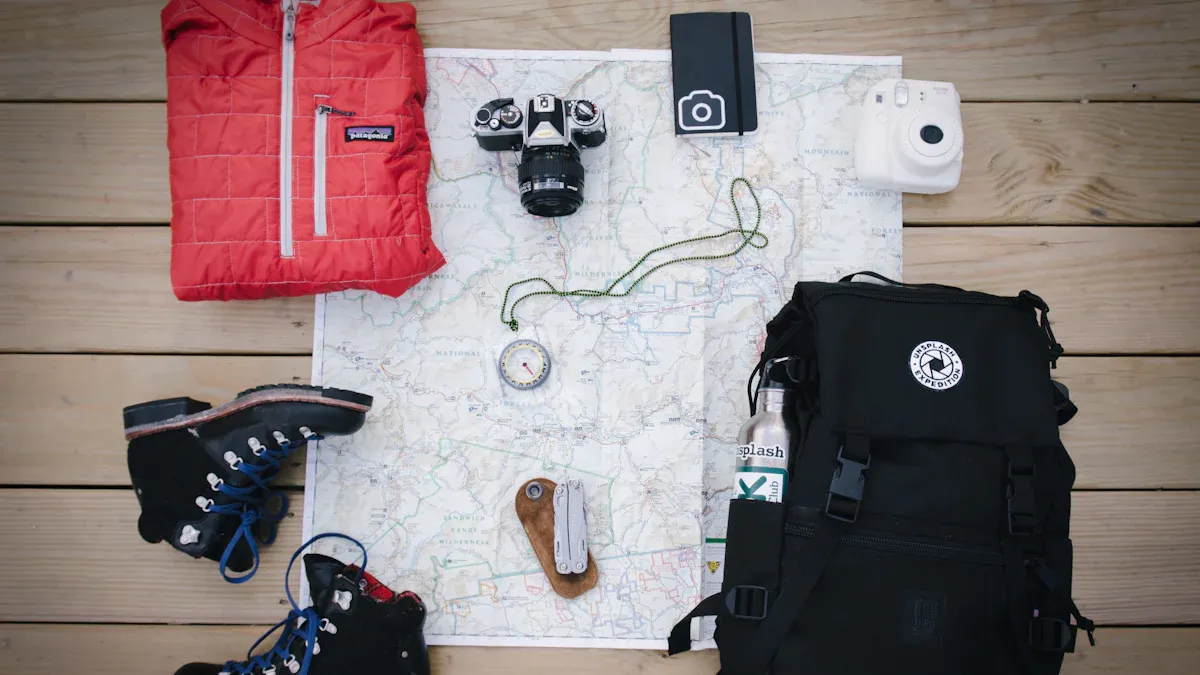Drying Bags vs Storage Bags for Backpacking and Hiking

You want your gear to stay dry and organized when you head outdoors. Choosing between a drying bag and storage bag depends on your trip and the weather you expect. Backpackers say durability matters most, with tough materials like nylon and Dyneema lasting longer. Waterproofing helps if you face wet conditions. Lightweight options make hiking easier. You also care about how much the bags pack down and what they cost. Picking the right bag means looking at what’s most important for your adventure.
Key Takeaways
- Drying bags keep your gear dry when it is wet outside. Use them in rain, when crossing rivers, or when boating.
- Storage bags help you organize your gear but do not stop water. They are light and help save space in your backpack.
- Pick drying bags for things that cannot get wet, like electronics and clothes. Use storage bags for clothes and food that do not need to stay dry.
- Use both types of bags for the best results. Use drying bags when it is wet and storage bags to keep things neat.
- Think about your trip and the weather before picking bags. Drying bags are needed for wet trips. Storage bags are good for dry places.
Quick Comparison
Drying Bag and Storage Bag Overview
When you get ready for a hike, you want to know what each bag does. Drying bags and storage bags both help you keep your gear in order, but they are not the same. Drying bags, which people also call dry bags, use strong materials like PVC or TPU. These bags keep your clothes and electronics dry. You close them by rolling the top and snapping it shut. This keeps out rain and splashes. Some dry bags, like the NRS Expedition DriDuffel or Yeti Panga, stop all water from getting in. Others only block light rain.
Storage bags, or stuff sacks, use lighter materials like treated nylon. They help you sort your gear inside your backpack. These bags are not waterproof, but they are light and save space. You might see brands like Overland Vehicle Systems make both kinds. When you look at drying bags and storage bags, think about what you need more: waterproofing or less weight.
At-a-Glance Table
Here is a simple table to show the main differences:
| Feature | Drying Bag (Dry Bag) | Storage Bag (Stuff Sack) |
|---|---|---|
| Waterproofing | Fully waterproof or splashproof | Not waterproof, only water-resistant |
| Material | Heavy-duty PVC or TPU | Lightweight treated nylon |
| Durability | Withstands harsh conditions | Durable for daily use, not for water |
| Closure Mechanism | Roll-top with clasp | Drawstring or zipper |
| Weight | Heavier due to thick material | Very light and easy to pack |
| Packability | Less compressible | Packs down small |
| Price | Usually more expensive | Budget-friendly |
| Best Use Cases | Wet weather, kayaking, river crossings | Organizing clothes, sleeping bags, food |
Tip: If you think it will rain or you will cross rivers, using both a drying bag and a storage bag can help keep your gear safe and neat.
What Are They?

Drying Bag Explained
When people say drying bag, they often mean dry bag. You use a dry bag to keep your things safe from water. Dry bags are great for hiking in rain or crossing rivers. They also work well for boating trips. The main job of a dry bag is to keep water out. You close the bag by rolling the top and snapping it shut. This makes a seal that keeps your clothes, food, and electronics dry.
Dry bags are made from strong materials like PVC, TPU, or vinyl-coated nylon. These materials help the bag last a long time, even in bad weather. Dry bags usually have roll-top closures or airtight zippers. You can use them for kayaking, canoeing, or hiking in wet places. Some people use dry sacks too. Dry sacks are lighter and fit inside your backpack. They protect your gear from rain or condensation.
Note: Dry bags are watertight and made for tough conditions. They help you feel calm when you expect wet weather.
Here’s a quick look at how dry bags and dry sacks are different:
| Type | Definition | Intended Use |
|---|---|---|
| Dry Bag | A waterproof pouch that keeps things dry during water activities. | Keeps gear safe from water in boating, kayaking, or hiking in wet places. |
| Dry Sack | A lighter sack for backpackers to protect gear inside a pack. | Protects gear from rain or condensation, used inside a backpack. |
Storage Bag (Stuff Sack) Explained
A storage bag, or stuff sack, helps you organize your things in your backpack. You use these bags to separate clothes, sleeping bags, or food. Storage bags do not keep water out. They make packing easier and faster. Most storage bags use light nylon and have a drawstring or zipper.
Storage bags come in many sizes and colors. This helps you find what you need without searching your whole pack. Storage bags are not made for bad weather. They are made to keep your things sorted and easy to grab.
Here’s how companies show the differences:
| Feature | Dry Bags | Storage Bags |
|---|---|---|
| Watertight | Yes, made to be watertight | No, usually not watertight |
| Durability | High, made for tough conditions | Changes, not for harsh places |
| Materials | PVC, TPU, or vinyl-coated nylon | Many types, often not waterproof |
| Closure Type | Roll-tops or airtight zippers | Simple closures |
When you look at drying bags and storage bags, you see each has a special job. Dry bags keep your things safe from water. Storage bags help you keep your backpack neat and organized.
Key Differences

Moisture Management
When you pack for a trip, you want to keep your gear dry. Drying bags do this best. They use waterproof materials like PVC or TPU. You roll the top and snap it shut. This keeps water out, even if you drop the bag in a river. Drying bags protect your electronics, clothes, and food from rain and splashes. If you use a drying bag and storage bag together, you get extra protection for your most important items.
Storage bags, or stuff sacks, help you organize your gear. They do not keep water out. If it rains, your things can get wet inside a storage bag. These bags work well for sorting clothes or packing a sleeping bag, but they do not stop moisture. When you want to keep things dry, always choose a drying bag.
Keeping your gear dry helps prevent mold, rust, and damage. Drying bags give you peace of mind in wet weather.
Weight & Packability
You care about how much your pack weighs. Drying bags use thick, heavy-duty fabrics. This makes them heavier than storage bags. They also do not compress as much. If you want to save weight, storage bags are a better choice. They use thin nylon and pack down very small. You can fit more storage bags in your backpack without adding much weight.
Field tests show that both drying bags and storage bags help you organize your pack. Ziploc bags are another lightweight option for keeping small items dry. They add almost no weight and make it easy to find what you need. If you want the lightest setup, use storage bags for most gear and a drying bag for things that must stay dry.
Durability & Price
You want your bags to last. Drying bags are tough. They use strong materials like double-coated polyurethane or ripstop nylon. Many have welded seams, which last longer than glued seams. Some brands even offer a lifetime warranty. Drying bags resist scratches and tears, but heat and sun can wear them out over time. Some companies use UV-resistant materials to help them last longer.
Storage bags are not as tough. They work well for daily use, but they do not stand up to rough treatment or water. Storage bags cost less than drying bags. If you need to save money, storage bags are a good pick for organizing gear that does not need to stay dry.
- Drying bags: Heavy-duty, 400–600 denier fabrics, welded seams, often lifetime warranty.
- Storage bags: Lightweight nylon, less durable, lower price.
Versatility & Use Cases
You can use a drying bag and storage bag in many ways. Drying bags work best for trips where you might get wet. Use them for kayaking, river crossings, or rainy hikes. Many backpackers put sleeping bags, jackets, and electronics in drying bags to keep them safe. You can also use drying bags as a pillow or to carry water in a pinch.
Storage bags help you sort your gear. Use them for clothes, food, or a sleeping bag. They come in many sizes and colors, so you can find things fast. Storage bags do not protect against water, but they make packing simple and neat.
- Use drying bags for moisture-sensitive gear and wet conditions.
- Use storage bags for organizing and saving weight.
Tip: Mix and match both types of bags for the best results on your next adventure.
Pros and Cons
Drying Bag Pros & Cons
When you look at drying bags, you find some clear benefits and a few drawbacks. Here’s what you get:
- You can seal out water and keep your gear dry, even in heavy rain.
- You protect electronics, food, and clothes from moisture and bugs.
- You find them easy to use. Just roll the top and snap it shut.
- You get a strong handle for carrying or tying to your pack.
- You do not need to worry about maintenance. These bags last a long time.
Heads up: Drying bags can trap moisture inside if you pack wet gear. This can cause mildew. If you get a hole, it is hard to fix. Some bags feel heavy and bulky compared to other options. Most drying bags come in only one color, so finding your gear fast can be tricky.
Here’s a quick table to help you see the main points:
| Advantages | Disadvantages |
|---|---|
| Seals out water completely | Can be heavy and bulky |
| Protects valuable gear | Hard to repair if punctured |
| Easy to carry and use | Not good for full submersion |
| Needs no maintenance | Moisture inside can cause mildew |
Storage Bag Pros & Cons
Storage bags, or stuff sacks, offer a different set of pros and cons. You might like these bags for their light weight and flexibility.
- You can organize your clothes, food, and gear with ease.
- You save space in your backpack. These bags pack down small.
- You find many sizes and colors, which makes sorting simple.
- You can reuse them, which helps cut down on waste.
- You can clean some types in the dishwasher.
But you should know about the downsides:
- Storage bags do not keep water out. Your gear can get wet in the rain.
- Some bags cost more than you expect, especially reusable silicone types.
- Cleaning can be tough if you pack messy food.
- Some bags wrinkle clothes or do not keep sandwiches neat.
Tip: When you compare a drying bag and storage bag, you see each one has a special job. Pick the one that fits your trip best.
Recommendations: Drying Bag and Storage Bag
Trip Type & Weather
When you plan your next adventure, think about where you’re going and what the weather looks like. If you expect rain, river crossings, or high humidity, you need to keep your gear dry. Dry bags work best for wet conditions. They seal out water and protect your clothes, electronics, and food.
In high humidity people tend to sweat more so even though you might be able to keep it from the rain you might still experience absorbing moisture from your bag. A light synthetic fill bag is preferable because it will dry faster if it gets wet.
Synthetic fill bags dry quickly, which helps in humid places. If you hike in dry weather or just want to organize your gear, storage bags make packing easy. They are light and pack down small. You can use them for clothes, snacks, or sleeping bags.
Here’s a quick guide for choosing:
- Use drying bags for rainy hikes, kayaking, or trips near water.
- Use storage bags for dry climates, short hikes, or when you want to save weight.
- Mix both types if you want to keep some items dry and others organized.
Personal Needs
Your personal needs matter when you pick a bag. Do you want waterproofing, less weight, or better organization? You might care about price, too. Some people like to use several bags to sort their gear. Others want one simple bag for everything.
Here’s a table to help you decide:
| Factor | Drying Bags | Storage Bags |
|---|---|---|
| Waterproofing | Essential for water exposure | Less critical, but still beneficial |
| Weight | Lightweight materials preferred | Heavier materials may be acceptable |
| Organization | Often requires multiple bags | Typically single bag usage |
You might choose a PVC bag for short trips on water. Nylon and TPU bags feel lighter and work well for long hikes. Many hikers use more than one drying bag and storage bag to organize different items.
Watch out for common mistakes:
- Not sealing your dry bag tightly can let water in.
- Overpacking can stress seams and cause leaks.
- Ignoring wear and tear can lead to bag failure.
- Using dry bags for dust or impact protection may not work well.
Tip: Always check your bag before your trip. Make sure you seal it properly and don’t overpack.
If you want to keep things simple, pick a storage bag for organizing and a drying bag for wet conditions. You can adjust your choice based on your budget and what you need most.
You have learned how drying bags and storage bags help on trips. Dry bags keep your gear dry, even if you drop them in water. They can last up to 10 years. Storage bags help you sort your things, but they do not stop water well. Look at this table to see the differences:
| Feature | Dry Bags | Standard Waterproof Bags |
|---|---|---|
| Waterproofing Effectiveness | 100% after submersion | 70-80% effectiveness |
| Durability | Lasts 7-10 years | Needs replacement every 2 years |
| Cost Efficiency | More cost-effective over time | Lower initial cost but higher long-term costs |
- Dry bags help you save money because they stop water damage.
- Storage bags are lighter and easy to fit in your pack.
Choose the bag that works best for your trip. You can try both types and tell us which one you like in the comments!
FAQ
What is the main difference between a drying bag and a storage bag?
A drying bag keeps your gear dry in wet places. A storage bag helps you organize your things inside your backpack. You use a drying bag for water protection. You use a storage bag for sorting and saving space.
What should you pack in a drying bag?
You should pack anything that must stay dry. This includes your phone, camera, clothes, and food. If you cross rivers or hike in rain, put your electronics and spare clothes in a drying bag.
What can you use a storage bag for?
You can use a storage bag to sort your clothes, snacks, or sleeping bag. These bags help you find things fast. You can also use them to keep dirty clothes separate from clean ones.
What size drying bag do you need for a day hike?
For a day hike, a 10- to 20-liter drying bag works well. This size fits your spare clothes, lunch, and small electronics. If you carry more gear, pick a bigger bag.
What is the best way to seal a drying bag?
Roll the top of the bag at least three times. Snap the buckle shut. This keeps water out. Always check the seal before you pack your bag in your backpack.
See also
Why BSCI and ISO Certification Matter When Choosing a Cycling Bag Factory
Why Every Outdoor Explorer Needs A Waterproof Dry Bag
What Sets Waterproof Dry Bags Apart for Travel and Camping
What Are the Best Alternatives to a Waterproof Dry Bag in 2025



Comments are closed